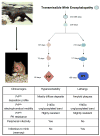The prion strain phenomenon: molecular basis and unprecedented features
- PMID: 17254754
- PMCID: PMC2597801
- DOI: 10.1016/j.bbadis.2006.12.006
The prion strain phenomenon: molecular basis and unprecedented features
Abstract
Prions are unconventional infectious agents responsible for transmissible spongiform encephalopathies. Compelling evidences indicate that prions are composed exclusively by a misfolded form of the prion protein (PrP(Sc)) that replicates in the absence of nucleic acids. One of the most challenging problems for the prion hypothesis is the existence of different strains of the infectious agent. Prion strains have been characterized in most of the species. Biochemical characteristics of PrP(Sc) used to identify each strain include glycosylation profile, electrophoretic mobility, protease resistance, and sedimentation. In vivo, prion strains can be differentiated by the clinical signs, incubation period after inoculation and the lesion profiles in the brain of affected animals. Sources of prion strain diversity are the inherent conformational flexibility of the prion protein, the presence of PrP polymorphisms and inter-species transmissibility. The existence of the strain phenomenon is not only a scientific challenge, but it also represents a serious risk for public health. The dynamic nature and inter-relations between strains and the potential for the generation of a large number of new prion strains is the perfect recipe for the emergence of extremely dangerous new infectious agents.
Figures


Similar articles
-
A closer look at prion strains: characterization and important implications.Prion. 2013 Mar-Apr;7(2):99-108. doi: 10.4161/pri.23490. Epub 2013 Jan 28. Prion. 2013. PMID: 23357828 Free PMC article. Review.
-
Insights into prion strains and neurotoxicity.Nat Rev Mol Cell Biol. 2007 Jul;8(7):552-61. doi: 10.1038/nrm2204. Nat Rev Mol Cell Biol. 2007. PMID: 17585315 Review.
-
Prion encephalopathies of animals and humans.Dev Biol Stand. 1993;80:31-44. Dev Biol Stand. 1993. PMID: 8270114 Review.
-
The shifting biology of prions.Brain Res Brain Res Rev. 2001 Oct;36(2-3):241-8. doi: 10.1016/s0165-0173(01)00100-x. Brain Res Brain Res Rev. 2001. PMID: 11690621 Review.
-
The neuropathological phenotype in transgenic mice expressing different prion protein constructs.Philos Trans R Soc Lond B Biol Sci. 1994 Mar 29;343(1306):415-23. doi: 10.1098/rstb.1994.0038. Philos Trans R Soc Lond B Biol Sci. 1994. PMID: 7913760 Review.
Cited by
-
Adaptation of the protein misfolding cyclic amplification (PMCA) technique for the screening of anti-prion compounds.FASEB J. 2024 Jul 31;38(14):e23843. doi: 10.1096/fj.202400614R. FASEB J. 2024. PMID: 39072789 Free PMC article.
-
A closer look at prion strains: characterization and important implications.Prion. 2013 Mar-Apr;7(2):99-108. doi: 10.4161/pri.23490. Epub 2013 Jan 28. Prion. 2013. PMID: 23357828 Free PMC article. Review.
-
Synthetic Prion Selection and Adaptation.Mol Neurobiol. 2019 Apr;56(4):2978-2989. doi: 10.1007/s12035-018-1279-2. Epub 2018 Aug 3. Mol Neurobiol. 2019. PMID: 30074230
-
Treatment with a non-toxic, self-replicating anti-prion delays or prevents prion disease in vivo.Mol Psychiatry. 2018 Mar;23(3):777-788. doi: 10.1038/mp.2017.84. Epub 2017 Jun 20. Mol Psychiatry. 2018. PMID: 28630454 Free PMC article.
-
The Role of Vesicle Trafficking Defects in the Pathogenesis of Prion and Prion-Like Disorders.Int J Mol Sci. 2020 Sep 23;21(19):7016. doi: 10.3390/ijms21197016. Int J Mol Sci. 2020. PMID: 32977678 Free PMC article. Review.
References
-
- Collinge J. Prion diseases of humans and animals: their causes and molecular basis. Annu Rev Neurosci. 2001;24:519–550. - PubMed
-
- Budka H, Aguzzi A, Brown P, Brucher JM, Bugiani O, Gullotta F, Haltia M, Hauw JJ, Ironside JW, Jellinger K. Neuropathological diagnostic criteria for Creutzfeldt-Jakob disease (CJD) and other human spongiform encephalopathies (prion diseases) Brain Pathol. 1995;5:459–466. - PubMed
-
- Soto C. Unfolding the role of protein misfolding in neurodegenerative diseases. Nat Rev Neurosci. 2003;4:49–60. - PubMed
-
- Cohen CH, Valleron AJ. When did bovine spongiform encephalopathy (BSE) start? Implications on the prediction of a new variant of Creutzfeldt-Jakob disease (nvCJD) epidemic. Int J Epidemiol. 1999;28:526–531. - PubMed
Publication types
MeSH terms
Substances
Grants and funding
LinkOut - more resources
Full Text Sources
Research Materials

